Design of Double-Roller Anisotropic Force-Feeding Device for the D200 Single Screw Straw Fiber Extruder
Abstract
1. Introduction
2. Materials and Methods
2.1. D200 Single Screw Straw Fiber Extruder
2.2. Force-Feeding Device
2.3. Mechanical Analysis and Kinematics Analysis of Straw
2.3.1. Kinematics Analysis
2.3.2. Mechanical Analysis
2.4. Auxiliary Roller
2.5. Spindle Speed
2.6. Line Speed Difference
2.7. Experimental Materials and Equipment
2.8. Experimental Design
2.9. Detection Method
3. Results
3.1. Experimental Results
3.2. Regression Model and Variance Analysis
4. Discussion
4.1. Interaction on Feeding Rate of the Force-Feeding Device
4.2. Effect of Interaction on Loss of Force-Feeding Device
4.3. Parameter Optimization
4.4. Verification Experiment
5. Conclusions
Author Contributions
Funding
Institutional Review Board Statement
Data Availability Statement
Acknowledgments
Conflicts of Interest
References
- Liu, G.; Zuo, Y.; Zhang, Q.; Yang, L.; Zhao, E.; Liang, L.; Tong, Y. Ridge-furrow with plastic film and straw mulch increases water availability and wheat production on the Loess Plateau. Sci. Rep. 2018, 8, 6503. [Google Scholar] [CrossRef] [PubMed]
- Nelson, T.F.; Remke, S.C.; Kohler HP, E.; McNeill, K.; Sander, M. Quantification of synthetic polyesters from biodegradable mulch films in soils. Environ. Sci. Technol. 2020, 54, 266–275. [Google Scholar] [CrossRef] [PubMed]
- Li, S.; Ding, F.; Flury, M.; Wang, Z.; Xu, L.; Li, S.; Jones, D.L.; Wang, J. Macro-and microplastic accumulation in soil after 32 years of plastic film mulching. Environ. Pollut. 2022, 300, 118945. [Google Scholar] [CrossRef] [PubMed]
- Yin, D.; Wu, M.; Li, D. Microstructure and creep properties of ultramicronized corn stover with straw-starch blended film. J. Agric. Mach. 2016, 47, 297–304. [Google Scholar]
- Liu, H.; Chen, H.; Hou, L.; Zhang, Y. Optimization Design and Experiment of Raw Material Supply System for D200 straw fibre making machine. Trans. Chin. Soc. Agric. Mach. 2017, 48, 92–98. [Google Scholar]
- Shen, F.; Wang, Q.; Li, Y.; Li, X.; Hu, J. Hydrothermal sulfite pretreatment of chrysanthemum straw with highly concentrated substrate enzymatic hydrolysis test. J. Agric. Mach. 2014, 45, 168–173. [Google Scholar]
- Zhang, H. Study on Preparation of Regenerated Cellulose Film from Fine Components of Corn Straw Pulping by Alkaline Method. Ph.D. Thesis, Kunming University of Science and Technology, Kunming, China, 2019. [Google Scholar]
- Yang, Y. Study on Pretreatment of Straw with Ionic Liquid/Low Eutectic Solvent and Its Mechanism. Ph.D. Thesis, University of Chinese Academy of Sciences (Institute of Process Engineering, CAS), Beijing, China, 2021. [Google Scholar]
- Guo, J.; Guo, Y.; Zhao, Q.; Wu, S.; Dong, R. Effects of fungus solid carrier pretreatment on degradation of non-sterilized corn straw. Trans. Chin. Soc. Agric. Mach. 2016, 47, 197–202. [Google Scholar]
- Aravinth, K.; Ramakrishnan, T.; Tamilarasan, V.D.; Veeramanikandan, K. A brief review on plant fibres composites: Extraction, chemical treatment and fibre orientation. Mater. Today Proc. 2022, 62, 2005–2009. [Google Scholar] [CrossRef]
- Dhali, K.; Daver, F.; Cass, P.; Adhikari, B. Isolation and characterization of cellulose nanomaterials from jute bast fibers. J. Environ. Chem. Eng. 2021, 9, 106447. [Google Scholar] [CrossRef]
- Mi, C.Q.; Mclean, A.G.; Arnold, P. Optimal mechanical design of single span screw feeders. Powder Handl. Process. J. 1991, 3, 227–239. [Google Scholar]
- Haaker, G.; Jongejan, M.; Bekhuis, J. A method to optimize screw feeder geometry for equable draw-down performance. Powder Handl. Process 1994, 6, 209–214. [Google Scholar]
- Roberts, A. The influence of granular vortex motion on the volumetric performance of enclosed screw conveyors. Powder Technol. 1999, 104, 56–67. [Google Scholar] [CrossRef]
- Roberts, A.W.; Willis, A.H. Performance of Grain Augers. Proc. Inst. Mech. Eng. 1962, 176, 165–194. [Google Scholar] [CrossRef]
- Chen, H.; Miao, N.; Dong, B.; Dun, G.; Zhang, Y. Experimental study on structure optimization of D200 straw fibre making machine. J. Northeast. Agric. Univ. 2015, 46, 90–94. [Google Scholar] [CrossRef]
- Jin, B.; Zhang, Y.; Zhang, M.; Zhong, W.; Sun, Z. Study on the flow behavior of biomass straw in the filling hopper. J. Sol. Energy 2008, 29, 1131–1134. [Google Scholar]
- Chen, H.; Zhang, Y.; Huang, Z.; Fang, X.; Li, L. Effect of Moisture content on the flow dynamics characteristics of rice straw. J. Northeast. Agric. Univ. 2013, 44, 90–94. [Google Scholar]
- Song, G. Combined Design Study of Screw-Mesh Cold-Feed Extruder. Master’s Thesis, Qingdao University of Science and Technology, Qingdao, China, 2010. [Google Scholar]
- Liu, H.; Jiang, L.; Chen, H.; Xia, J.; Li, L. Working Parameters Optimization and Performance Test of Rice Straw Fiber making Machine. Trans. Chin. Soc. Agric. Mach. 2020, 51, 161–169. [Google Scholar]
- Zheng, X. Modular Design and Research of Spiral Meshing Cold Feed Extruder. Ph.D. Thesis, Qingdao University of Science and Technology, Qingdao, China, 2011. [Google Scholar]
- Ge, X. Study on the preparation of floating aquafeed containing straw based on twin-screw extrusion and expansion technology. Master’s Thesis, Yangzhou University, Yangzhou, China, 2019. [Google Scholar]
- Cao, X.; He, J.; Zhang, B. Numerical Simulation of Mud Extrusion Process under Different Rotating Speeds of Meshing Twin Screw. Acta Ceram. Sin. 2015, 36, 678–682. [Google Scholar]
- Yang, T. Screw Geometry and Computer Aided Design of Differential Twin Screw Kneader. Master’s Thesis, Chongqing University, Chongqing, China, 2006. [Google Scholar]
- Fan, G.; Niu, C.; Zhang, Z.; Wang, D.; Mao, W.; Jiang, H. Design and experiment of V-shaped anti-drift spraying device for multi-airflow cooperative orchard. J. Agric. Mach. 2022, 53, 138–147. [Google Scholar]
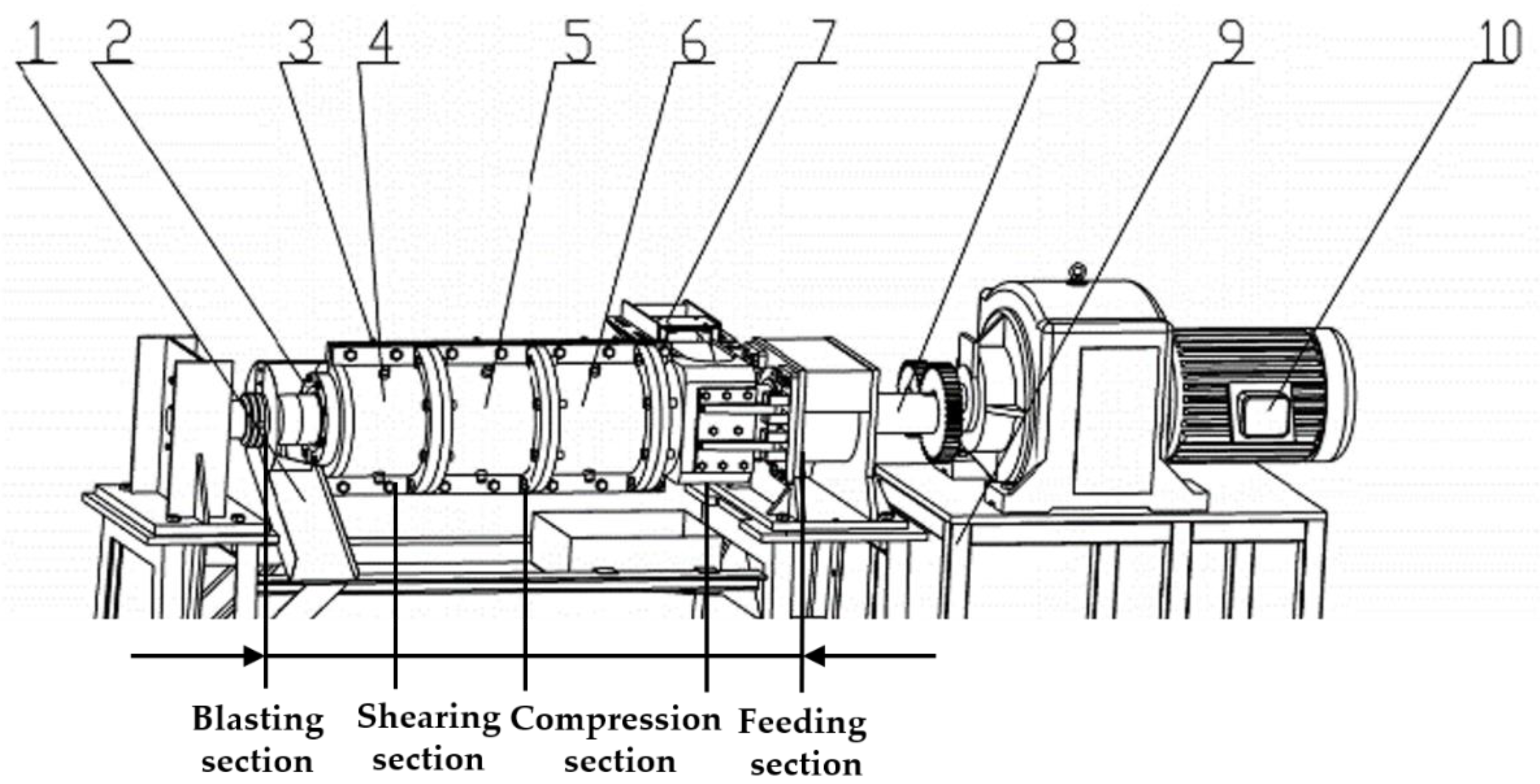
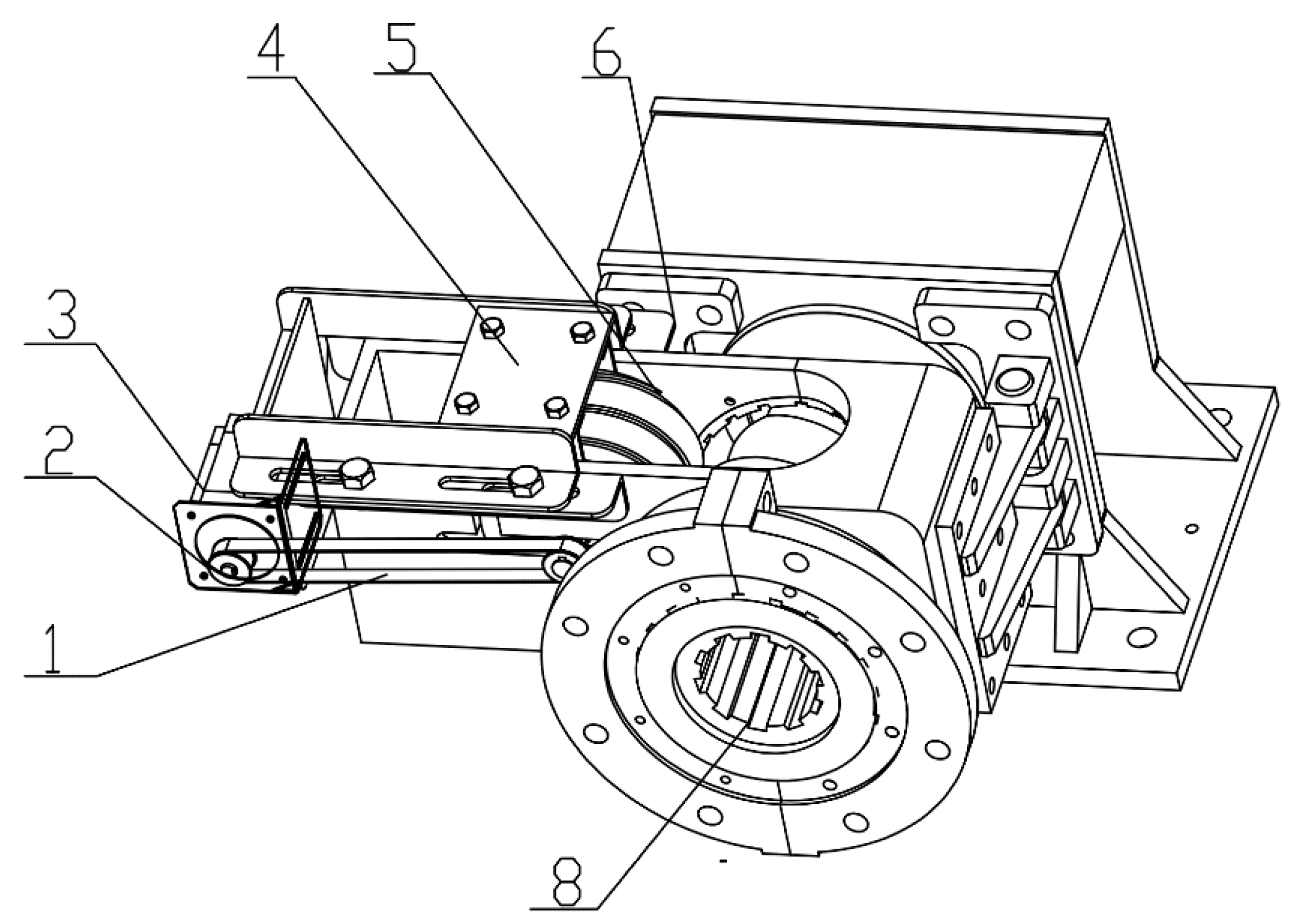
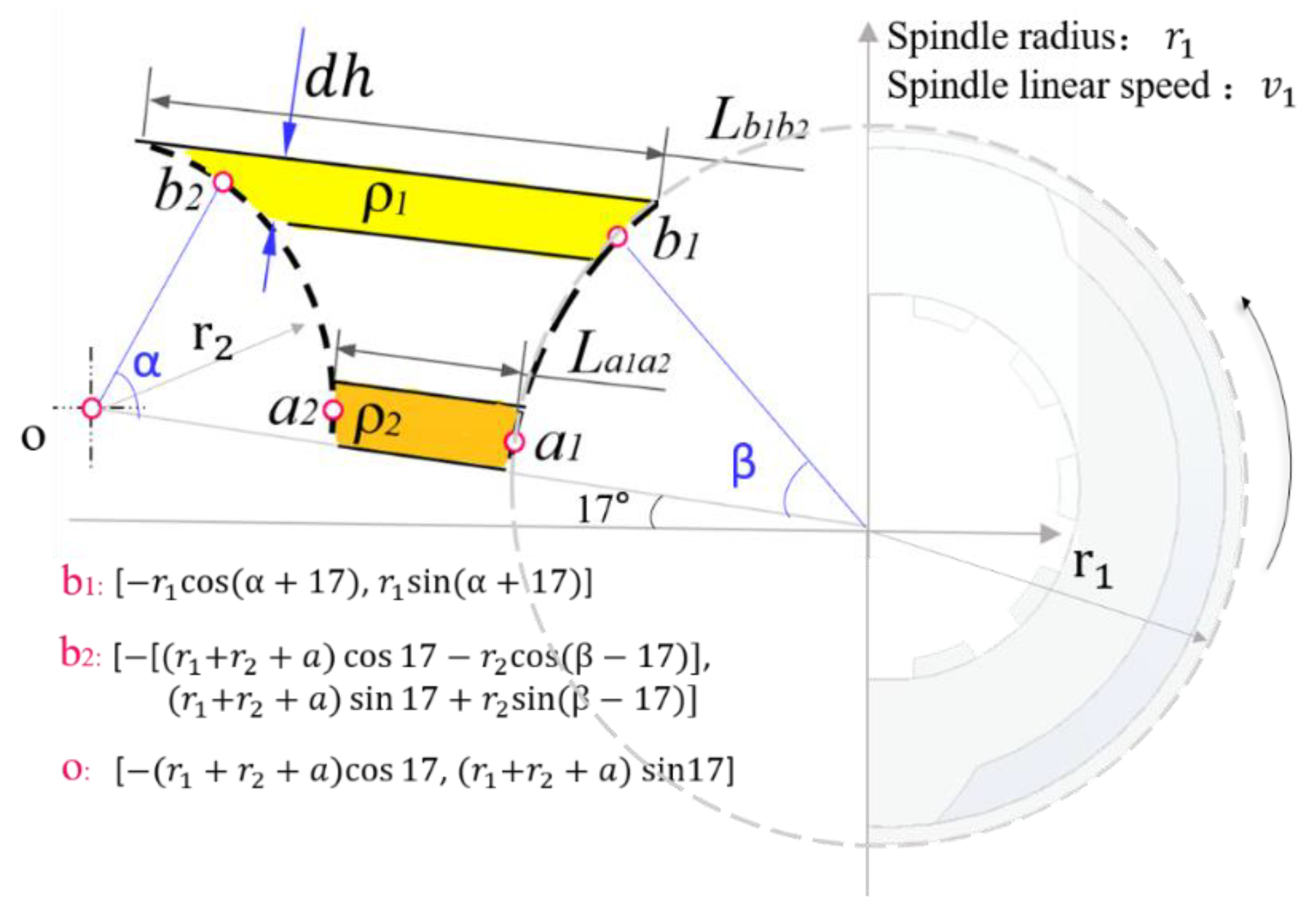

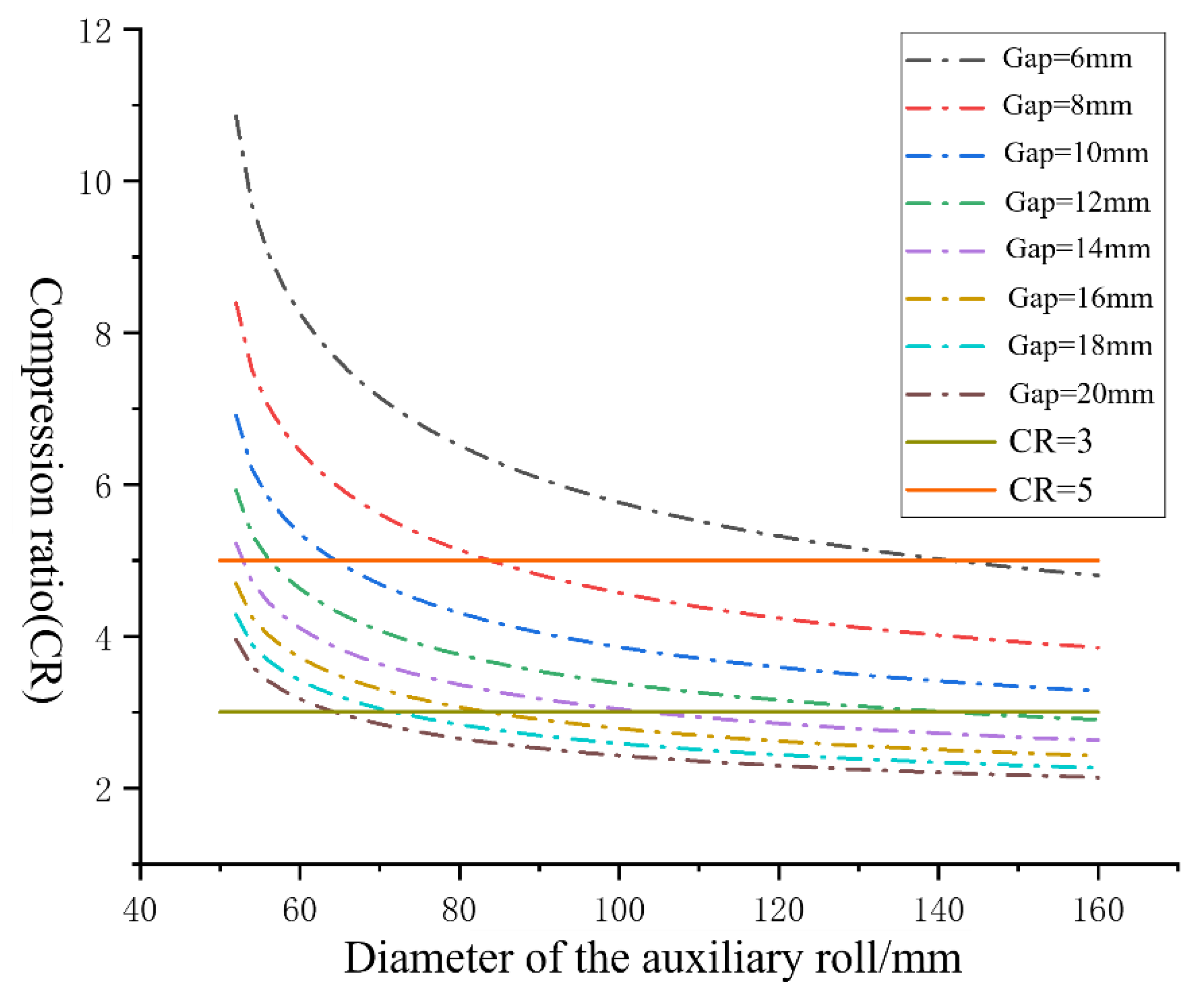

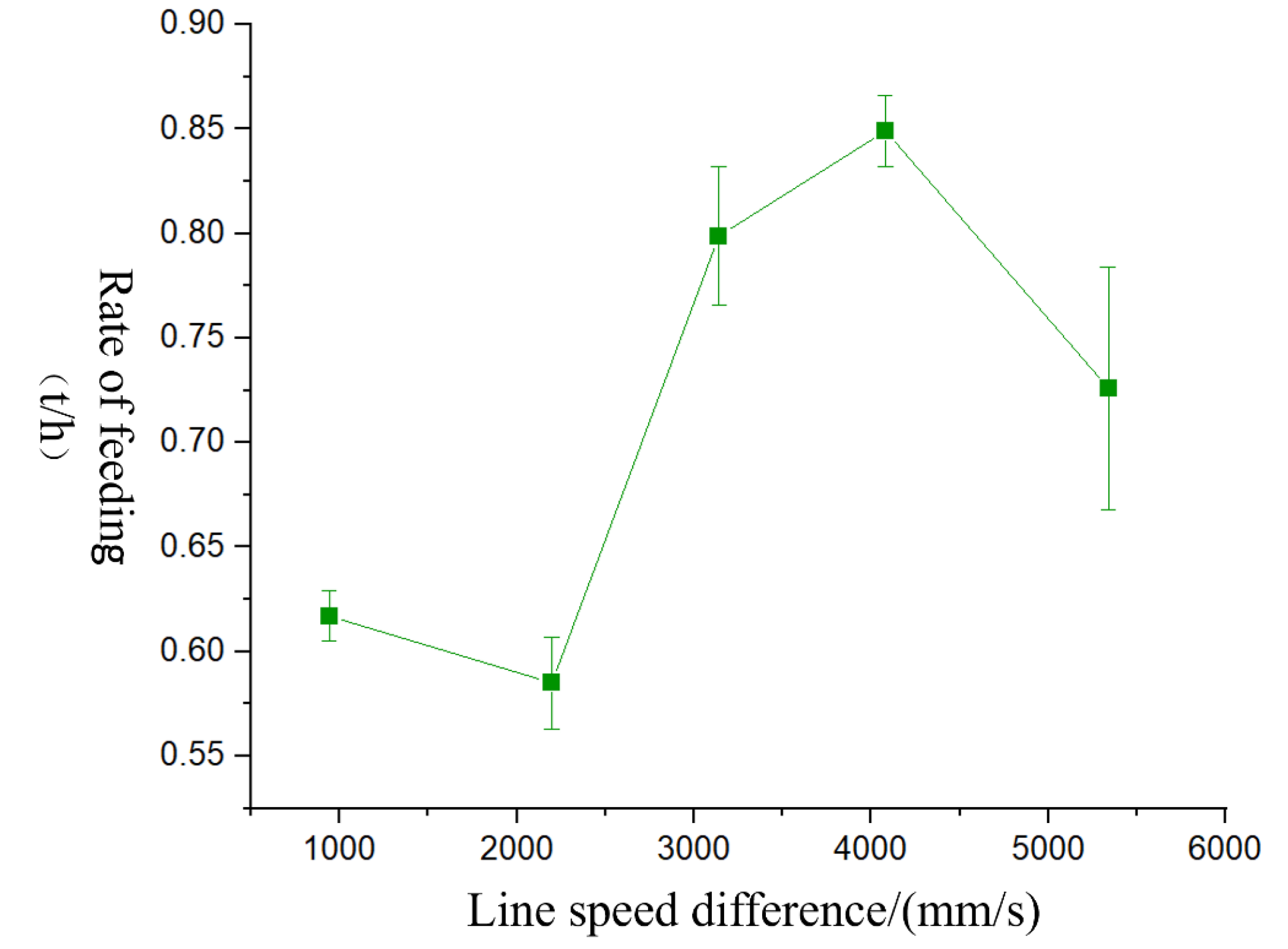
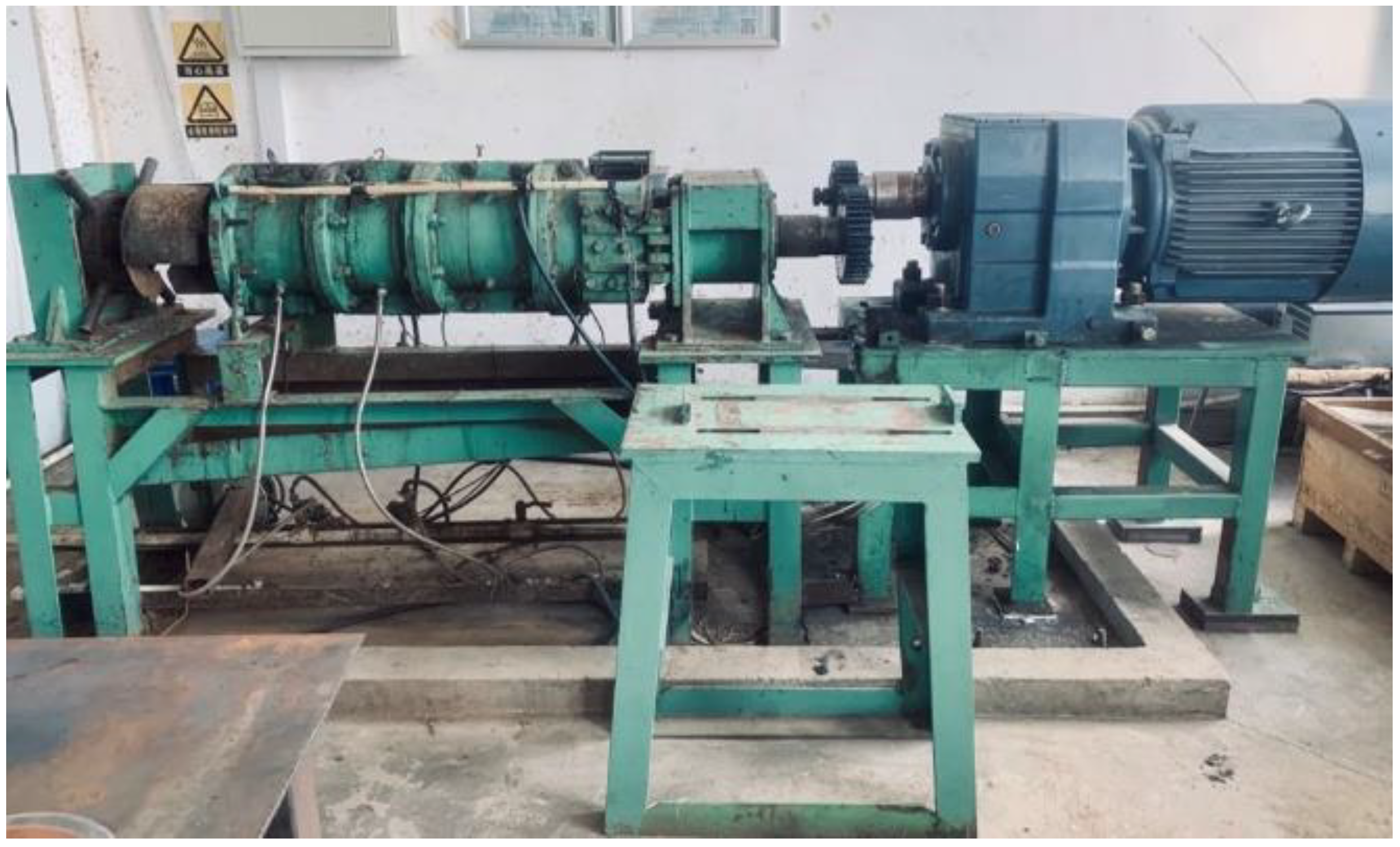
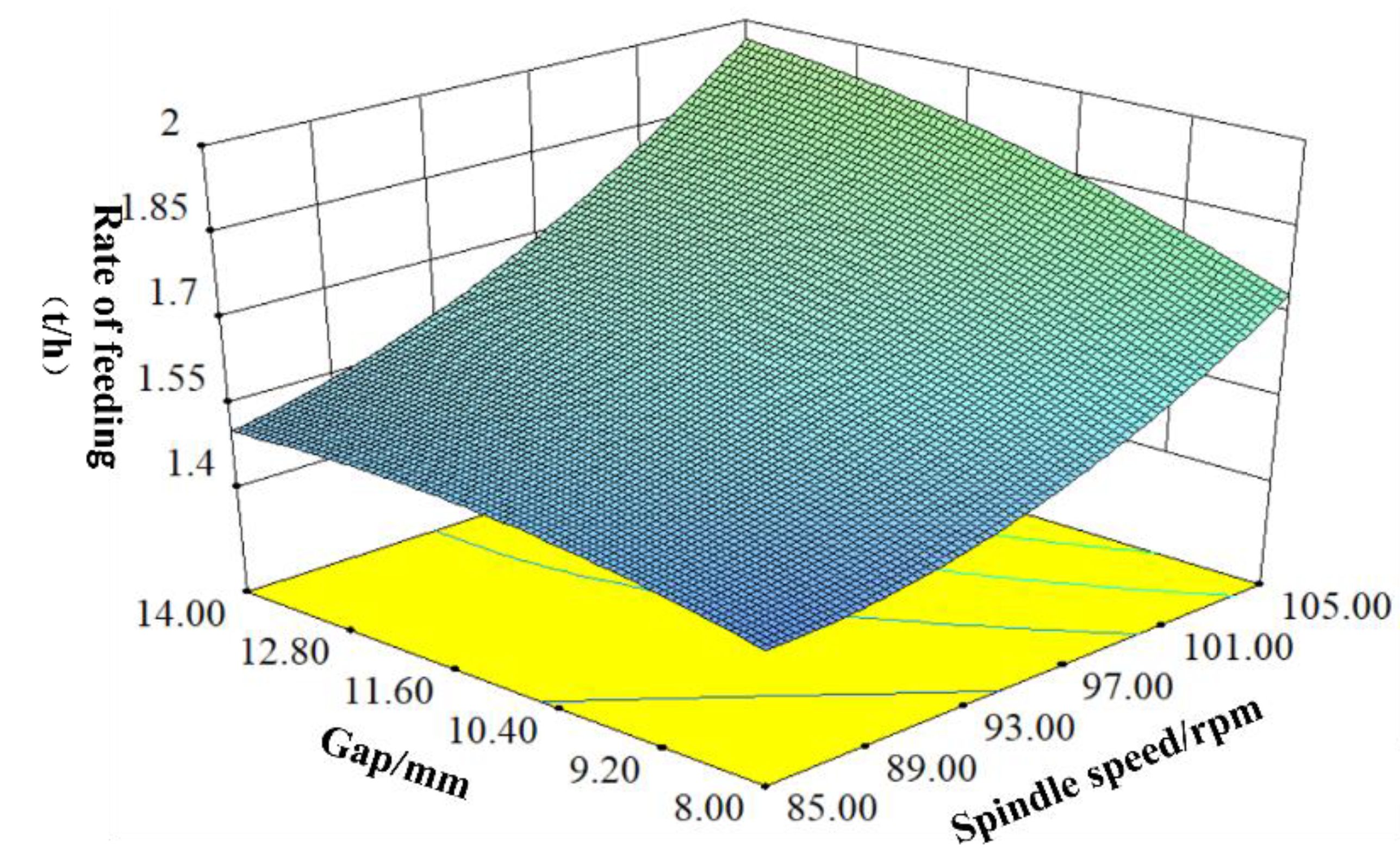
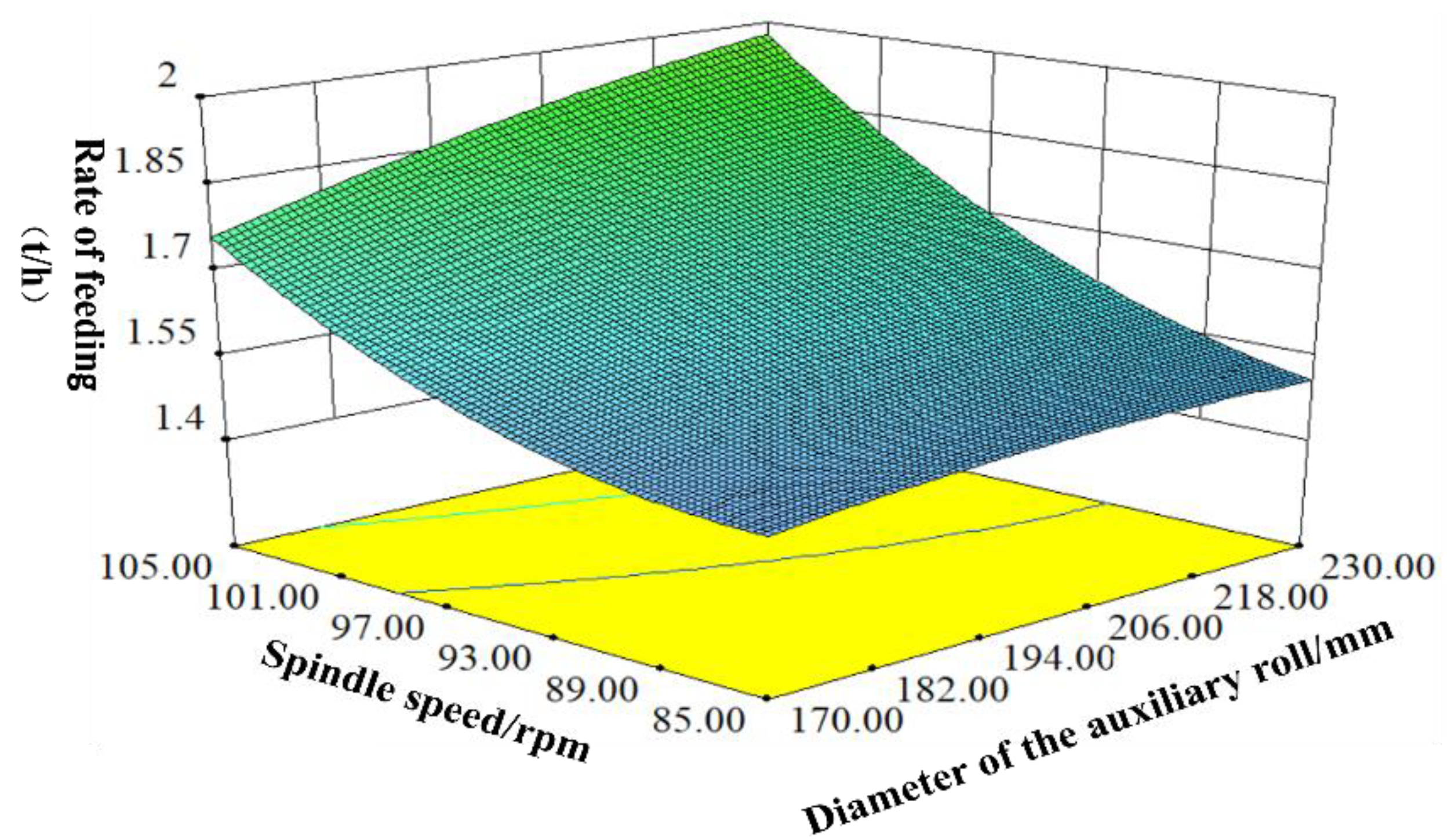
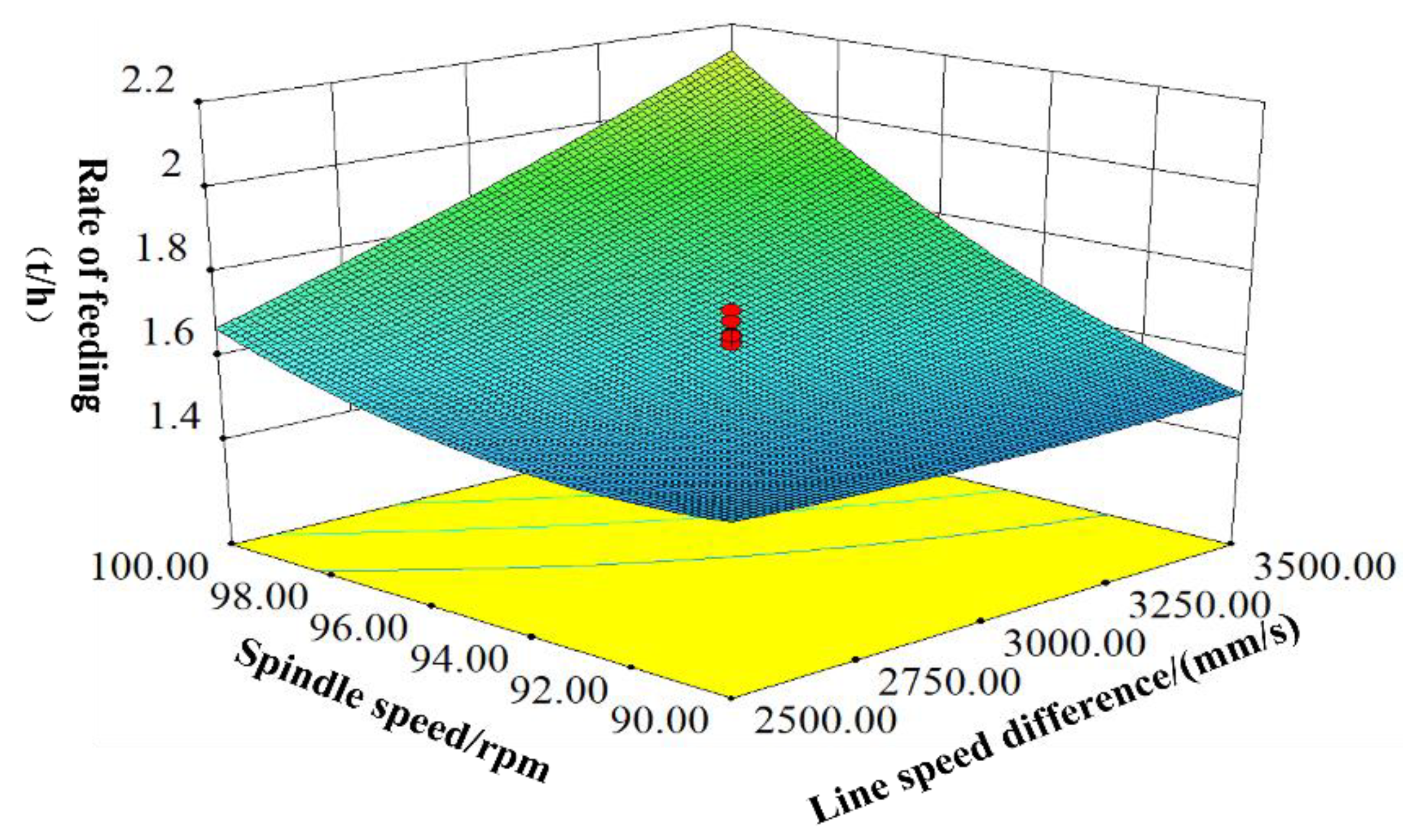
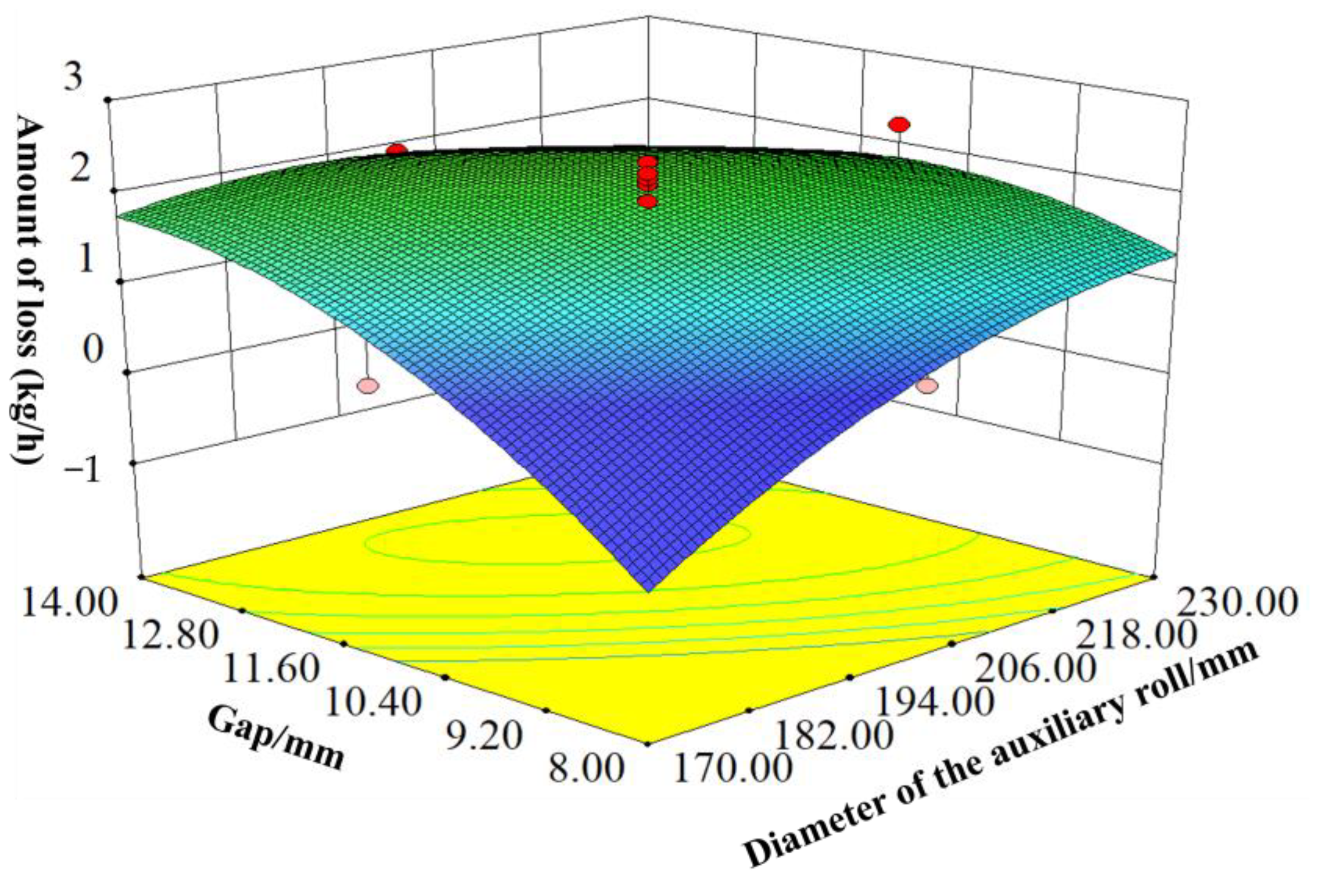

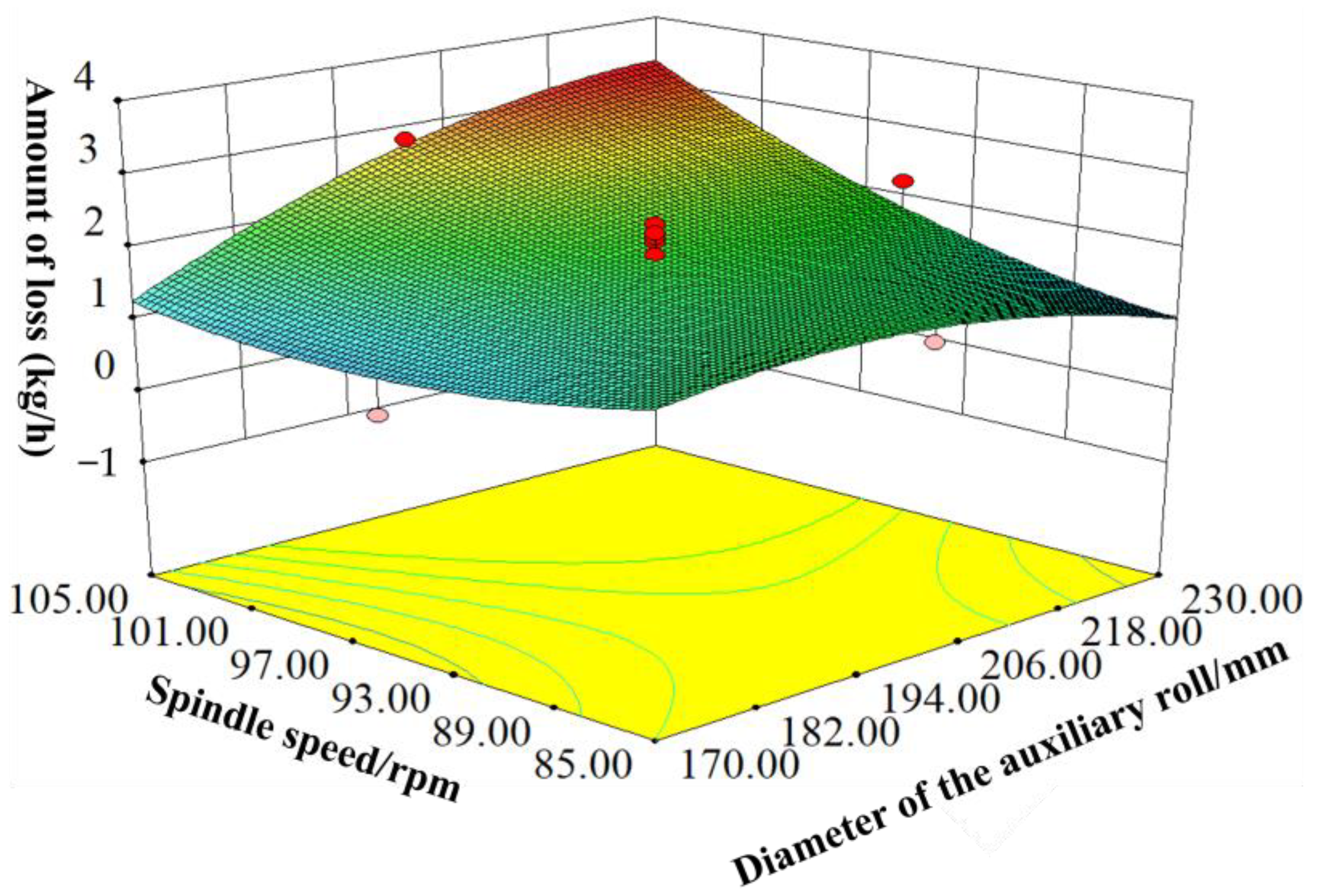

| Parameters | Value |
|---|---|
| Poisson’s ratio | 0.4 |
| The density of rice straw | 241 kg/m−3 |
| Shear modulus of straw | 1 × 106 Pa |
| Coefficient of recovery between straw | 0.357 |
| Coefficient of static friction between straw | 0.44 |
| Coefficient of dynamic friction between straw | 0.55 |
| Straw-component recovery coefficient | 0.23 |
| Straw-component static friction factor | 0.363 |
| Straw-component dynamic friction factor | 0.465 |
| Spindle Speed (rpm) | Line Speed Difference/(mm/s) | Feeding Rate/(t/h) | Rate of Loss/% |
|---|---|---|---|
| 85 | 2000 | 0.363 | 17.3 |
| 4000 | 0.459 | 18.2 | |
| 6000 | 0.436 | 25.2 | |
| 100 | 2000 | 0.475 | 12.7 |
| 4000 | 0.524 | 14.1 | |
| 6000 | 0.499 | 21.4 | |
| 115 | 2000 | 0.512 | 9.4 |
| 4000 | 0.657 | 11.8 | |
| 6000 | 0.535 | 17.3 |
| Level | Experimental Factors | |||
|---|---|---|---|---|
| Diameter of the Auxiliary Roll X1/(mm) | Line Speed Difference X2/(mm/s) | Spindle Speed X3/(r/min) | Gap X4/(mm) | |
| +2 | 230 | 4000 | 105 | 14 |
| +1 | 215 | 3500 | 100 | 12.5 |
| 0 | 200 | 3000 | 95 | 11 |
| −1 | 185 | 2500 | 90 | 9.5 |
| −2 | 170 | 2000 | 85 | 8 |
| No. | Experimental Factors | Test Index | ||||
|---|---|---|---|---|---|---|
| Diameter of Rollers X1 | Line Speed Difference X2 | Spindle Speed X3 | Gap X4 | Feeding Rate Y1 | Amount of Loss Y2 | |
| 1 | 200.0 | 3000 | 95.0 | 11.00 | 1.588 | 0.028 |
| 2 | 200.0 | 3000 | 95.0 | 11.00 | 1.613 | 0.03 |
| 3 | 200.0 | 4000 | 95.0 | 11.00 | 1.883 | 0.045 |
| 4 | 230.0 | 3000 | 95.0 | 11.00 | 1.667 | 0.037 |
| 5 | 185.0 | 2500 | 100.0 | 12.50 | 1.519 | 0.029 |
| 6 | 215.0 | 3500 | 90.0 | 9.50 | 1.444 | 0.023 |
| 7 | 215.0 | 2500 | 100.0 | 9.50 | 1.73 | 0.034 |
| 8 | 200.0 | 3000 | 95.0 | 11.00 | 1.643 | 0.031 |
| 9 | 200.0 | 3000 | 95.0 | 11.00 | 1.654 | 0.029 |
| 10 | 200.0 | 3000 | 95.0 | 11.00 | 1.713 | 0.028 |
| 11 | 200.0 | 3000 | 95.0 | 8.00 | 1.328 | 0.01 |
| 12 | 200.0 | 3000 | 95.0 | 11.00 | 1.465 | 0.025 |
| 13 | 200.0 | 3000 | 95.0 | 11.00 | 1.597 | 0.036 |
| 14 | 215.0 | 3500 | 90.0 | 12.50 | 1.537 | 0.032 |
| 15 | 200.0 | 3000 | 95.0 | 11.00 | 1.655 | 0.039 |
| 16 | 185.0 | 2500 | 100.0 | 9.50 | 1.495 | 0.022 |
| 17 | 200.0 | 3000 | 105.0 | 11.00 | 2.344 | 0.047 |
| 18 | 200.0 | 3000 | 85.0 | 11.00 | 1.504 | 0.026 |
| 19 | 215.0 | 2500 | 90.0 | 12.50 | 1.526 | 0.024 |
| 20 | 185.0 | 2500 | 90.00 | 9.50 | 1.432 | 0.018 |
| 21 | 185.0 | 3500 | 100.0 | 12.50 | 2.173 | 0.039 |
| 22 | 185.0 | 3500 | 90.0 | 9.50 | 1.428 | 0.017 |
| 23 | 185.0 | 2500 | 90.0 | 12.50 | 1.465 | 0.025 |
| 24 | 170.0 | 3000 | 95.0 | 11.00 | 1.458 | 0.01 |
| 25 | 215.0 | 2500 | 100.0 | 12.50 | 1.617 | 0.031 |
| 26 | 200.0 | 3000 | 95.0 | 14.00 | 1.658 | 0.032 |
| 27 | 215.0 | 3500 | 100.0 | 12.50 | 2.449 | 0.049 |
| 28 | 200.0 | 3000 | 95.0 | 11.00 | 1.632 | 0.03 |
| 29 | 215.0 | 3500 | 100.0 | 9.50 | 1.975 | 0.04 |
| 30 | 200.0 | 3000 | 95.0 | 11.00 | 1.687 | 0.032 |
| 31 | 200.0 | 3000 | 95.0 | 11.00 | 1.652 | 0.037 |
| 32 | 185.0 | 3500 | 90.0 | 12.50 | 1.457 | 0.054 |
| 33 | 200.0 | 2000 | 95.0 | 11.00 | 1.505 | 0.027 |
| 34 | 185.0 | 3500 | 100.0 | 9.50 | 1.673 | 0.031 |
| 35 | 215.0 | 2500 | 90.0 | 9.50 | 1.463 | 0.024 |
| 36 | 200.0 | 3000 | 95.0 | 11.00 | 1.614 | 0.035 |
| Source of Variation | Quadratic Sum | Degree of Freedom | Mean Square | F-Value | p-Value | |
|---|---|---|---|---|---|---|
| Y1 | Model | 1.98 | 14 | 0.14 | 22.59 | <0.0001 |
| Residual | 0.13 | 21 | 6.250 | |||
| Lack of fit | 0.089 | 10 | 8.884 | 2.3 | 0.0936 | |
| Error | 0.042 | 11 | 3.855 | 2.30 | ||
| Sum | 2.11 | 35 | ||||
| Y2 | Model | 2.686 | 14 | 1.916 | 6.97 | <0.0001 |
| Residual | 5.783 | 21 | 2.751 | |||
| Lack of fit | 3.816 | 10 | 3.815 | 2.14 | 0.1145 | |
| Error | 1.963 | 11 | 1.783 | |||
| Sum | 3.264 | 35 | ||||
| Title | Feeding Rate/(t/h) | Amount of Loss/(kg/h) |
|---|---|---|
| Experimental results | 2.366 | 2.016 |
| 2.294 | 1.746 | |
| 2.413 | 2.046 | |
| 2.447 | 1.734 | |
| 2.379 | 2.004 | |
| Average value | 2.3798 | 1.908 |
| Optimized value | 2.449 | 1.974 |
| Relative error rate | 2.83% | 3.28% |
Disclaimer/Publisher’s Note: The statements, opinions and data contained in all publications are solely those of the individual author(s) and contributor(s) and not of MDPI and/or the editor(s). MDPI and/or the editor(s) disclaim responsibility for any injury to people or property resulting from any ideas, methods, instructions or products referred to in the content. |
© 2023 by the authors. Licensee MDPI, Basel, Switzerland. This article is an open access article distributed under the terms and conditions of the Creative Commons Attribution (CC BY) license (https://creativecommons.org/licenses/by/4.0/).
Share and Cite
Li, L.; Zhao, C.; Gao, C.; Fan, S.; Wang, X.; Chen, H.; Ji, W. Design of Double-Roller Anisotropic Force-Feeding Device for the D200 Single Screw Straw Fiber Extruder. Agriculture 2023, 13, 670. https://doi.org/10.3390/agriculture13030670
Li L, Zhao C, Gao C, Fan S, Wang X, Chen H, Ji W. Design of Double-Roller Anisotropic Force-Feeding Device for the D200 Single Screw Straw Fiber Extruder. Agriculture. 2023; 13(3):670. https://doi.org/10.3390/agriculture13030670
Chicago/Turabian StyleLi, Longhai, Chengshun Zhao, Chuang Gao, Siyuan Fan, Xing Wang, Haitao Chen, and Wenyi Ji. 2023. "Design of Double-Roller Anisotropic Force-Feeding Device for the D200 Single Screw Straw Fiber Extruder" Agriculture 13, no. 3: 670. https://doi.org/10.3390/agriculture13030670
APA StyleLi, L., Zhao, C., Gao, C., Fan, S., Wang, X., Chen, H., & Ji, W. (2023). Design of Double-Roller Anisotropic Force-Feeding Device for the D200 Single Screw Straw Fiber Extruder. Agriculture, 13(3), 670. https://doi.org/10.3390/agriculture13030670







